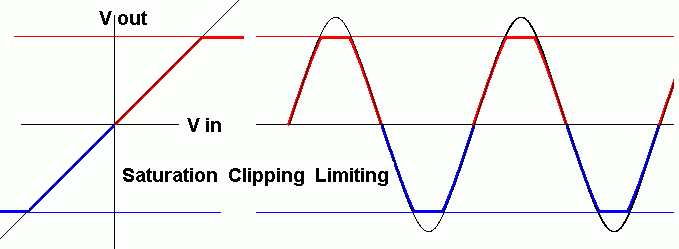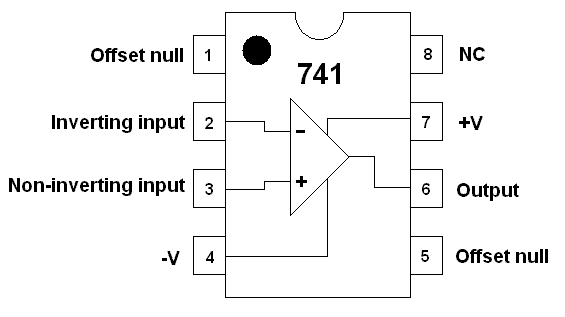
RANDOM PAGE
SITE SEARCH
LOG
IN
SIGN UP
HELP
To gain access to revision questions, please sign up and log in.
Everyone
Ideal Operational Amplifier Properties
| Characteristics |
Ideal |
Real - Depends on the model
|
| GAIN: Open Loop |
Infinity |
> 100000 or 1000000 typical
|
| Input Resistance: (Impedance) |
Infinity |
> 1M (Bipolar) > 1000M (FET)
|
| Output Resistance: (Impedance) |
Zero |
100 - 1000R
|
SATURATION High:
Highest Output Voltage |
Positive Power Supply Voltage
Typical value = 12 V.
|
Two volts below the positive supply
Typical value = 10 V.
|
SATURATION Low:
Lowest Output Voltage |
Negative Power Supply Voltage
Typical value = -12 V.
|
Two volts above the negative supply
Typical value = -10 V.
|
| Gain Bandwidth Product: |
Infinity |
1 - 20MHz
|
| Input offset voltage: |
Zero |
Often Adjustable to Zero
|
Saturation
Clipping or Limiting
- An ideal op amp could provide an infinite output voltage range.
- A very good op amp could provide outputs at least up to the power supply voltages.
- Most op amps fall short by about two volts so with a 12 volt supply, the output would be only ten volts.
- The output should be directly proportional to the input. That is perfectly linear.
The image below shows ideal (black) and non-ideal (red and blue) behaviour including clipping when the op amp is saturated and the output voltage can go no higher.

Amplifiers increase the magnitude of the input signal.
Gain is a number (with no units) used to describe how much bigger a signal becomes when it is amplified.

- Voltage Gain = Vout / Vin
- Current Gain = Currentout / Currentin
- Power Gain = Powerout / Powerin
Amplifiers have one or more of the following properties.
- The output voltage may be bigger than the input voltage
- The output current may be bigger than the input current
- The output power may be bigger than the input power
- High input impedance (AC equivalent of resistance)
- Low output impedance (AC equivalent of resistance)
Voltage Bandwidth
The voltage bandwidth of an op amp is the frequency over which the output is at least 70% (0.7) of the maximum output voltage of the circuit.
Power Bandwidth
The power bandwidth of an op amp is the frequency over which the output is at least 50% (0.5) of the maximum output power of the circuit.
The 741 Operational Amplifier
Pinout

Pins
- Offset Null - Rarely used. It can be used to to adjust for small errors in the two inputs so zero volts in gives zero volts out.
- Inverting Input - If this voltage increases, the output voltage will go DOWN unless the Op Amp is already saturated.
- Non-Inverting Input - If this voltage increases, the output voltage will go UP unless the Op Amp is already saturated.
- The minus supply - Sometimes this is connected to zero volts ( ground ). Sometimes it's connected to a voltage between -5V and -18V.
- Offset Null - Rarely used. It can be used to to adjust for small errors in the two inputs so zero volts in gives zero volts out.
- The Output - In an ideal Op Amp, the maximum and minimum output voltage is equal to the power supply voltages. In a real life Op Amp, these voltages are about 2 to 3 Volts less.
- The plus supply - Voltages from +5V to +18V are common. There are specialist and more expensive Op Amps with a higher voltage ratings.
- No Connection - This pin is not used.
Data Sheet
The 741 is a low cost operational amplifier. It has ...
- A very high open loop gain (close to infinity)
- Very high input resistance (close to infinity)
- Low output resistance (close to zero)
- A rather poor gain bandwidth product compared with slightly more expensive op' amp's.
- It's very easy to use. Higher performance devices often oscillate and are much harder to work with.
It can be used to make ...
- Comparators (compare two voltages)
- Inverting Amplifiers (make the input signal bigger and invert it)
- Voltage Follower. An inverting amplifier with a voltage gain of one.
- Non Inverting Amplifiers (make the input signal bigger without inverting it)
- Summing Amplifiers (add two or more input voltages and amplify and invert the result)
- Difference (subtracting) Amplifiers (subtract two input voltages and amplify the result)
- A2 Only: Schmitt Trigger (compare the input with two different reference voltages).
reviseOmatic V3
Contacts, ©, Cookies, Data Protection and Disclaimers
Hosted at linode.com, London




